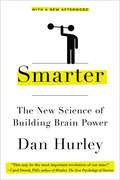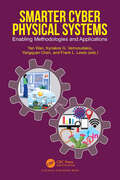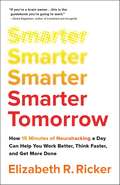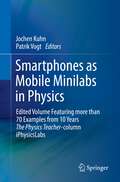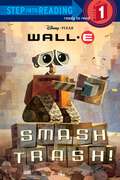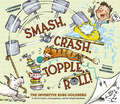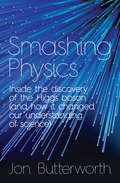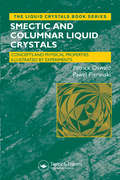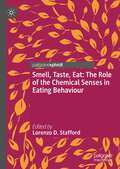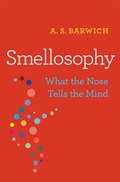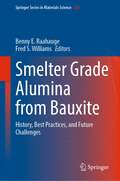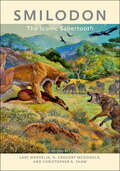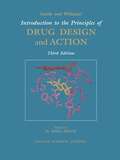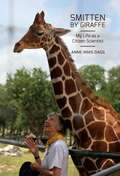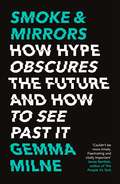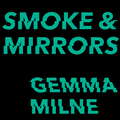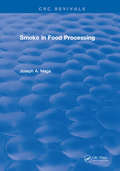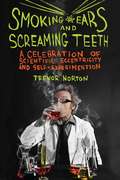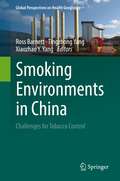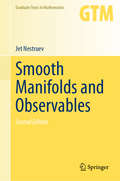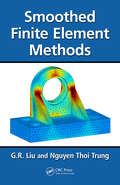- Table View
- List View
Smarter
by Dan HurleyCan you make yourself, your kids, and your parents smarter?Expanding upon one of the most-read New York Times Magazine features of 2012, Smarter penetrates the hot new field of intelligence research to reveal what researchers call a revolution in human intellectual abilities. Shattering decades of dogma, scientists began publishing studies in 2008 showing that "fluid intelligence"--the ability to learn, solve novel problems, and get to the heart of things--can be increased through training.But is it all just hype? With vivid stories of lives transformed, science journalist Dan Hurley delivers practical findings for people of every age and ability. Along the way, he narrates with acidtongued wit his experiences as a human guinea pig, road-testing commercial brain-training programs, learning to play the Renaissance lute, getting physically fit, even undergoing transcranial directcurrent stimulation.Smarter speaks to the audience that made bestsellers out of Train Your Mind, Change Your Brain and Moonwalking with Einstein.
Smarter Cyber Physical Systems: Enabling Methodologies and Applications
by Yangquan Chen Frank L. Lewis Kyriakos G. Vamvoudakis Yan WanCyber-Physical Systems (CPS) is featured by the tight integration of cyber and physical components. CPS has made major advances with a broad societal impact. Now in the era of Industry Revolution 4.0, CPS is considered as an enabling technology. Combined with autonomy, big data, machine learning and internet of things, CPS empowers systems with greater intelligence to address uncertainties, unknowns, attacks, and unexpected events.This book highlights the latest advances and explores the new trends in the design and implementation of smarter Cyber-Physical systems (CPS). It introduces integrated model-based and data-driven solutions for CPS that demonstrate features including both adaptability and interpretability. Key topics covered include reinforcement learning, digital twin and large-scale networks. The book then presents the latest codesign techniques that address practical computation, networking, control, and physical constraints. It examines important issues related to human CPS, safety, resilience and privacy. The chapters feature the tight integration of theory and practice, including problems motivated from applications, fundamental research development that are generally applicable, and implementation in real system applications. A wide range of CPS applications are covered, including robotics, autonomous driving, unmanned aerial vehicles and smart cities.
Smarter Tomorrow: How 15 Minutes of Neurohacking a Day Can Help You Work Better, Think Faster, and Get More Done
by Elizabeth R. RickerWhat if you could upgrade your brain in 15 minutes a day? Let Elizabeth Ricker, an MIT and Harvard-trained brain researcher turned Silicon Valley technologist, show you how.Join Ricker on a wild and edifying romp through the cutting-edge world of neuroscience and biohacking. You'll encounter Olympic athletes, a game show contestant, a memory marvel, a famous CEO, and scientists galore. From Ricker&’s decade-long quest, you will learn:● The brain-based reason so many self-improvement projects fail . . . But how a little-known secret of Nobel Prize winning scientists could finally unlock success● Which four abilities—both cognitive and emotional—can predict success in work and relationships . . . and a new system for improving all four● Which seven research-tested tools can supercharge mental performance. They range from low-tech (a surprising new mindset) to downright futuristic (an electrical device for at-home brain stimulation) Best of all, you will learn to upgrade your brain with Ricker&’s 20 customizable self-experiments and a sample, 12-week schedule. Ricker distills insights from dozens of interviews and hundreds of research studies from around the world. She tests almost everything on herself, whether it&’s nicotine, video games, meditation, or a little-known beverage from the Pacific islands. Some experiments fail hilariously—but others transform her cognition. She is able to sharpen her memory, increase her attention span, boost her mood, and clear her brain fog. By following Ricker&’s system, you&’ll uncover your own boosts to mental performance, too. Join a growing, global movement of neurohackers revolutionizing their careers and relationships. Let this book change 15 minutes of your day, and it may just change the rest of your life!
Smartphones as Mobile Minilabs in Physics: Edited Volume Featuring more than 70 Examples from 10 Years The Physics Teacher-column iPhysicsLabs
by Jochen Kuhn Patrik VogtThis book presents more than 70 physics experiments from iPhysicsLabs-column of the Journal The Physics Teacher. The articles are aimed at physics lecturers, trainee teachers and teachers who want to take their classes to the next level using digital devices. The experiments can easily be performed and analyzed using smartphones or tablets. The topics span from mechanics, optics, thermodynamics, astrophysics and astronomy to acoustics, electrodynamics and electronics.Authors worldwide have contributed to this series of articles. To celebrate the 10th anniversary of iPhysicsLabs, Jochen Kuhn and Patrik Vogt have collected more than 70 most popular and interesting articles for this book.
Smash Trash! (Step into Reading)
by RH DisneyMeet WALL•E in this Step 1 reader! It is the 29th Century and the Earth has been abandoned, but one robot has been left behind to collect and condense trash—WALL•E. This Step 1 Step into Reading book introduces early readers to Disney/Pixar WALL•E.
Smash, Crash, Topple, Roll!: The Inventive Rube Goldberg—A Life in Comics, Contraptions, and Six Simple Machines
by Catherine ThimmeshA joyfully illustrated picture book biography of Rube Goldberg for STEM-loving children and the many people who enjoy doing simple tasks the hard way.Award-winning author Catherine Thimmesh’s irresistibly engaging text and artist Shanda McCloskey’s energetic, cartoon-style artwork introduce readers to the life and creative legacy of Rube Goldberg, the world-famous inventor of crazy contraptions. A rollicking educational kids' book that is part biography, part inspiration, and part physics how-to, Smash, Crash, Topple, Roll! posits the ultimate question … why do anything the simple way? (Especially if, for instance, there is a catapult option?) Because, of course, there are lots of things you can do the simple way: Set an alarm, flip a switch, open a door, toast some bread . . . But what if, instead, you did things the Rube Goldberg way? Endlessly entertaining, needlessly complex, and achieving a delicate balance of physics, humor, and excitement! The book includes an overview of the six simple machines that power most of Goldberg’s inventions and puts the tools for making real-life Rube Goldberg machines right into readers’ hands. It’s the perfect thing to spark the imaginations of budding inventors, artists, and thinkers of all ages—because the most promising relationships with science start not with a textbook but with the willingness to break stuff and ask silly questions!SCIENCE MADE FUN: Sure to excite students, teachers, and parents looking for a playful, hands-on way to dive into the sciences and connect to STEM and STEAM efforts in schools, where Rube Goldberg machines are already in use, this book offers a fun way to approach the sometimes-daunting subject of physics. INSPIRATIONAL AWESOMENESS: There are more and better opportunities for kids to embrace and explore a love of science and engineering today, and Rube Goldberg was an artist, too! This is the perfect book to encourage the scientist and artist in every kid. POPULAR SUBJECT FOR KIDS: There are over 1 million views of various Rube Goldberg videos on YouTube featuring overly complicated ways to turn a page, pass the salt, water a plant, and more.Perfect for: Young makers Parents, grandparents, and caregivers encouraging budding engineers and artists Classroom book or gift for teachers Rube Goldberg fans of all ages
Smashing Physics
by Jon ButterworthThe discovery of the Higgs boson made headlines around the world. Two scientists, Peter Higgs and François Englert, whose theories predicted its existence, shared a Nobel Prize. The discovery was the culmination of the largest experiment ever run, the ATLAS and CMS experiments at CERN's Large Hadron Collider.But what really is a Higgs boson and what does it do? How was it found? And how has its discovery changed our understanding of the fundamental laws of nature? And what did it feel like to be part of it?Jon Butterworth is one of the leading physicists at CERN and this book is the first popular inside account of the hunt for the Higgs. It is a story of incredible scientific collaboration, inspiring technological innovation and ground-breaking science. It is also the story of what happens when the world's most expensive experiment blows up, of neutrinos that may or may not travel faster than light, and the reality of life in an underground bunker in Switzerland.This book will also leave you with a working knowledge of the new physics and what the discovery of the Higgs particle means for how we define the laws of nature. It will take you to the cutting edge of modern scientific thinking.
Smectic and Columnar Liquid Crystals: Concepts and Physical Properties Illustrated by Experiments (Liquid Crystals Book Series)
by Patrick Oswald Pawel PieranskiBased on graduate lectures given by the authors, Smectic and Columnar Liquid Crystals: Concepts and Physical Properties Illustrated by Experiments examines lamellar (smectic) and columnar liquid crystals, which, in addition to orientational order, possess 1D, 2D or 3D positional order. Topics include rheology and plasticity, ferroelectricity, analogies with superconductors, hexatic order and 2D-melting, equilibrium shapes, facetting, and the Mullins-Sekerka instability, as well as phase transitions in free films and membrane vibrations. Nematic and cholesteric liquid crystals are covered by the authors in a separate volume entitled Nematic and Cholesteric Liquid Crystals: Concepts and Physical Properties Illustrated by Experiments.
Smell, Taste, Eat: The Role of the Chemical Senses in Eating Behaviour
by Lorenzo D. StaffordThis edited collection synthesises recent research into smell and taste and relates it to eating behaviour. Olfaction - the sense of smell - together with taste are known as the ‘chemical senses’ and are the oldest sensory system. It is paradoxical then that our knowledge (especially psychological) about these two systems remains far behind that of vision and audition. Nevertheless, the past twenty years has seen a significant increase in our understanding of these sensory systems and the contributors to this book, many of whom helped to reveal key findings in this research domain, explore theories which attempt to explain appetite control, associative odour learning and multisensory perception, among others. It further brings the reader up to date on the current state of knowledge on disordered eating and olfactory disorders. Finally, it bridges across different academic disciplines to reveal the importance of the chemical senses in indigenous people in Guyana.
Smellosophy: What the Nose Tells the Mind
by A. S. BarwichA pioneering exploration of olfaction that upsets settled notions of how the brain translates sensory information. Decades of cognition research have shown that external stimuli “spark” neural patterns in particular regions of the brain. This has fostered a view of the brain as a space that we can map: here the brain responds to faces, there it perceives a sensation in your left hand. But it turns out that the sense of smell—only recently attracting broader attention in neuroscience—doesn’t work this way. A. S. Barwich asks a deceptively simple question: What does the nose tell the brain, and how does the brain understand it? Barwich interviews experts in neuroscience, psychology, chemistry, and perfumery in an effort to understand the biological mechanics and myriad meanings of odors. She argues that it is time to stop recycling ideas based on the paradigm of vision for the olfactory system. Scents are often fickle and boundless in comparison with visual images, and they do not line up with well-defined neural regions. Although olfaction remains a puzzle, Barwich proposes that what we know suggests the brain acts not only like a map but also as a measuring device, one that senses and processes simple and complex odors. Accounting for the sense of smell upsets theories of perception philosophers have developed. In their place, Smellosophy articulates a new model for understanding how the brain represents sensory information.
Smelter Grade Alumina from Bauxite: History, Best Practices, and Future Challenges (Springer Series in Materials Science #320)
by Benny E. Raahauge Fred S. WilliamsThis book provides a comprehensive review of the production of smelter grade alumina from bauxite ores. It emphasizes the best practices applied in the industry today but seen in a historical context with a view to future challenges and developments. The control of alumina quality is discussed in detail including the effects that alumina quality have on the aluminum smelter process with respect to environmental performance, current efficiency, and metal purity. The discussion of alumina quality will be relevant to people on the smelter side, as this is the interface between refinery and smelter. Emphasis is placed on the major steps of the Bayer Process including: digestion, clarification, precipitation, calcination, and management of water, energy, and bauxite residue. This book is a valuable resource for active, seasoned practitioners and for new engineers entering the industry.
Smilodon: The Iconic Sabertooth
by Edited by Lars Werdelin, H. Gregory McDonald, and Christopher A. ShawThe consummate guide to the ultimate sabertooth.Few animals spark the imagination as much as the sabertooth cat Smilodon. With their incredibly long canines, which hung like fangs past their jaws, these ferocious predators were first encountered by humans when our species entered the Americas. We can only imagine what ice age humans felt when they were confronted by a wild cat larger than a Siberian tiger.Because Smilodon skeletons are perennial favorites with museum visitors, researchers have devoted themselves to learning as much as possible about the lives of these massive cats. This volume, edited by celebrated academics, brings together a team of experts to provide a comprehensive and contemporary view of all that is known about Smilodon. The result is a detailed scientific work that will be invaluable to paleontologists, mammalogists, and serious amateur sabertooth devotees. The book • covers all major aspects of the animal's natural history, evolution, phylogenetic relationships, anatomy, biomechanics, and ecology • traces all three Smilodon species across both North and South America• brings together original, unpublished research with historical accounts of Smilodon's discovery in nineteenth-century BrazilThe definitive reference on these iconic Pleistocene mammals, Smilodon will be cited by researchers for decades to come. Contributors: John P. Babiarz, Wendy J. Binder, Charles S. Churcher, Larisa R. G. DeSantis, Robert S. Feranec, Therese Flink, James L. Knight, Margaret E. Lewis, Larry D. Martin, H. Gregory McDonald, Julie A. Meachen, William C. H. Parr, Ashley R. Reynolds. Kevin L. Seymour, Christopher A. Shaw, C. S. Ware, Lars Werdelin, H. Todd Wheeler, Stephen Wroe, M. Aleksander Wysocki
Smith and Williams' Introduction to the Principles of Drug Design and Action
by Hywel Williams H. John SmithAdvances in knowledge and technology have revolutionized the process of drug development, making it possible to design drugs for a given target or disease. Building on the foundation laid by the previous three editions, Smith and Williams Introduction to the Principles of Drug Design and Action, Fourth Edition includes the latest informatio
Smithsonian: The Complete Story from Sputnik to Curiousity (DK Definitive Visual Histories)
by Giles SparrowThis compelling story of exploration charts and celebrates humankind in space, from Sputnik's launch in 1957 through the Apollo Moon landings and the International Space Station to future missions to Mars and beyond.Spaceflight chronicles how, in the half-century that followed Sputnik, the world was revolutionized by space travel and exploration. The opening up of Earth's orbit to satellites led to a revolution in communications, monitoring of the environment, and materials science. For the human imagination, the impact has been even greater: the voyages of robotic space probes have transformed our view of the Solar System, while Earth-orbiting satellites and missions to the Moon have forever changed our view of ourselves. This book is a celebration of human ingenuity and imagination. From the work of pioneers like Wernher von Braun, Yuri Gagarin, and Neil Armstrong to the triumphs and tragedies that followed, it reveals the people, science, and technology that have propelled us into the Space Age.
Smitten by Giraffe: My Life as a Citizen Scientist
by Anne DaggWhen Anne Innis saw her first giraffe at the age of three, she was smitten. She knew she had to learn more about this marvelous animal. Twenty years later, now a trained zoologist, she set off alone to Africa to study the behaviour of giraffe in the wild. Subsequently, Jane Goodall and Dian Fossey would be driven by a similar devotion to study the behaviour of wild apes. In Smitten by Giraffe, the noted feminist reflects on her scientific work as well as the leading role she has played in numerous activist campaigns. On returning home to Canada, Anne married physicist Ian Dagg, had three children, published a number of scientific papers, taught at several local universities, and in 1967 earned her PhD in biology at the University of Waterloo. Dagg was continually frustrated in her efforts to secure a position as a tenured professor despite her many publications and exemplary teaching record. Finally she opted instead to pursue her research as an independent "citizen scientist," while working part-time as an academic advisor. Dagg would spend many years fighting against the marginalization of women in the arts and sciences. Boldly documenting widespread sexism in universities while also discussing Dagg's involvement with important zoological topics such as homosexuality, infanticide, sociobiology, and taxonomy, Smitten by Giraffe offers an inside perspective on the workings of scientific research and debate, the history of academia, and the rise of second-wave feminism.
Smitten by Giraffe: My Life as a Citizen Scientist (Footprints Series #28)
by Anne Innis DaggWhen Anne Innis saw her first giraffe at the age of three, she was smitten. She knew she had to learn more about this marvelous animal. Twenty years later, now a trained zoologist, she set off alone to Africa to study the behaviour of giraffe in the wild. Subsequently, Jane Goodall and Dian Fossey would be driven by a similar devotion to study the behaviour of wild apes. In Smitten by Giraffe, the noted feminist reflects on her scientific work as well as the leading role she has played in numerous activist campaigns. On returning home to Canada, Anne married physicist Ian Dagg, had three children, published a number of scientific papers, taught at several local universities, and in 1967 earned her PhD in biology at the University of Waterloo. Dagg was continually frustrated in her efforts to secure a position as a tenured professor despite her many publications and exemplary teaching record. Finally she opted instead to pursue her research as an independent “citizen scientist,” while working part-time as an academic advisor. Dagg would spend many years fighting against the marginalization of women in the arts and sciences. Boldly documenting widespread sexism in universities while also discussing Dagg’s involvement with important zoological topics such as homosexuality, infanticide, sociobiology, and taxonomy, Smitten by Giraffe offers an inside perspective on the workings of scientific research and debate, the history of academia, and the rise of second-wave feminism.
Smoke & Mirrors: How Hype Obscures the Future and How to See Past It
by Gemma Milne'Stop following the news until you've read Gemma Milne's persuasive analysis of the hype and bullshit that distort our understanding of emerging science. As she shows, the starting point to grasping the genuine opportunities of AI, life sciences and climate tech is a healthy dose of critical thinking'David Rowan, founding editor of WIRED UK and author of Non-Bullshit Innovation: Radical Ideas from the World's Smartest Minds'Couldn't be more timely. Fascinating and vitally important'Jamie Bartlett, author of The People Vs Tech'A much-needed blast of fresh air! Gemma Milne expertly shows us how to separate the truth from the hype surrounding the emerging techs of today, and those of the near-tomorrow'Lewis Dartnell, author of Origins: How the Earth Made Us'I loved this book! This is exactly the sort of sceptical, cut-through-the crap-but-still-excited-about-what's-emerging book around tech innovation that's sorely needed, yet is so hard to find . . . essential reading for anyone who's serious about how real-world advances might be effectively harnessed to build a better future'Dr Andrew Maynard, scientist and author of Films from the Future and Future Rising'[A] vital contribution in a world where technological progress promises so much, but too often disappoints. If, like me, you believe that advances in science and technology are our best hope for solving the grand challenges of our times, this book is the indispensable guide to avoiding the mirages and the charlatans along the way'Matt Clifford, co-founder and CEO of Entrepreneur First'A refreshingly grown-up, clear-headed look at the interaction between science, technology and the media - readable without being dumbed down, acknowledging complexities without being heavy'Tom Chivers, author of The AI Does Not Hate You'ROBOTS WILL STEAL YOUR JOB!''AI WILL REVOLUTIONISE FARMING!''GENETIC EDITING WILL CURE CANCER!'Bombastic headlines about science and technology are nothing new. To cut through the constant stream of information and misinformation on social media, or grab the attention of investors, or convince governments to take notice, strident headlines or bold claims seem necessary to give complex, nuanced information some wow factor.But hype has a dark side, too.It can mislead. It can distract. It can blinker us from seeing what is actually going on.From AI, quantum computing and brain implants, to cancer drugs, future foods and fusion energy, science and technology journalist Gemma Milne reveals hype to be responsible for fundamentally misdirecting or even derailing crucial progress.Hype can be combated and discounted, though, if you're able to see exactly where, how and why it is being deployed.This book is your guide to doing just that.
Smoke & Mirrors: How Hype Obscures the Future and How to See Past It
by Gemma Milne'Stop following the news until you've read Gemma Milne's persuasive analysis of the hype and bullshit that distort our understanding of emerging science. As she shows, the starting point to grasping the genuine opportunities of AI, life sciences and climate tech is a healthy dose of critical thinking'David Rowan, founding editor of WIRED UK and author of Non-Bullshit Innovation: Radical Ideas from the World's Smartest Minds'Couldn't be more timely. Fascinating and vitally important'Jamie Bartlett, author of The People Vs Tech'A much-needed blast of fresh air! Gemma Milne expertly shows us how to separate the truth from the hype surrounding the emerging techs of today, and those of the near-tomorrow'Lewis Dartnell, author of Origins: How the Earth Made Us'I loved this book! This is exactly the sort of sceptical, cut-through-the crap-but-still-excited-about-what's-emerging book around tech innovation that's sorely needed, yet is so hard to find . . . essential reading for anyone who's serious about how real-world advances might be effectively harnessed to build a better future'Dr Andrew Maynard, scientist and author of Films from the Future and Future Rising'[A] vital contribution in a world where technological progress promises so much, but too often disappoints. If, like me, you believe that advances in science and technology are our best hope for solving the grand challenges of our times, this book is the indispensable guide to avoiding the mirages and the charlatans along the way'Matt Clifford, co-founder and CEO of Entrepreneur First'A refreshingly grown-up, clear-headed look at the interaction between science, technology and the media - readable without being dumbed down, acknowledging complexities without being heavy'Tom Chivers, author of The AI Does Not Hate You'ROBOTS WILL STEAL YOUR JOB!''AI WILL REVOLUTIONISE FARMING!''GENETIC EDITING WILL CURE CANCER!'Bombastic headlines about science and technology are nothing new. To cut through the constant stream of information and misinformation on social media, or grab the attention of investors, or convince governments to take notice, strident headlines or bold claims seem necessary to give complex, nuanced information some wow factor.But hype has a dark side, too.It can mislead. It can distract. It can blinker us from seeing what is actually going on.From AI, quantum computing and brain implants, to cancer drugs, future foods and fusion energy, science and technology journalist Gemma Milne reveals hype to be responsible for fundamentally misdirecting or even derailing crucial progress.Hype can be combated and discounted, though, if you're able to see exactly where, how and why it is being deployed.This book is your guide to doing just that.
Smoke & Mirrors: How Hype Obscures the Future and How to See Past It
by Gemma Milne'Stop following the news until you've read Gemma Milne's persuasive analysis of the hype and bullshit that distort our understanding of emerging science. As she shows, the starting point to grasping the genuine opportunities of AI, life sciences and climate tech is a healthy dose of critical thinking'David Rowan, founding editor of WIRED UK and author of Non-Bullshit Innovation: Radical Ideas from the World's Smartest Minds'Couldn't be more timely. Fascinating and vitally important'Jamie Bartlett, author of The People Vs Tech'A much-needed blast of fresh air! Gemma Milne expertly shows us how to separate the truth from the hype surrounding the emerging techs of today, and those of the near-tomorrow'Lewis Dartnell, author of Origins: How the Earth Made Us'I loved this book! This is exactly the sort of sceptical, cut-through-the crap-but-still-excited-about-what's-emerging book around tech innovation that's sorely needed, yet is so hard to find . . . essential reading for anyone who's serious about how real-world advances might be effectively harnessed to build a better future'Dr Andrew Maynard, scientist and author of Films from the Future and Future Rising'[A] vital contribution in a world where technological progress promises so much, but too often disappoints. If, like me, you believe that advances in science and technology are our best hope for solving the grand challenges of our times, this book is the indispensable guide to avoiding the mirages and the charlatans along the way'Matt Clifford, co-founder and CEO of Entrepreneur First'A refreshingly grown-up, clear-headed look at the interaction between science, technology and the media - readable without being dumbed down, acknowledging complexities without being heavy'Tom Chivers, author of The AI Does Not Hate You'ROBOTS WILL STEAL YOUR JOB!''AI WILL REVOLUTIONISE FARMING!''GENETIC EDITING WILL CURE CANCER!'Bombastic headlines about science and technology are nothing new. To cut through the constant stream of information and misinformation on social media, or grab the attention of investors, or convince governments to take notice, strident headlines or bold claims seem necessary to give complex, nuanced information some wow factor.But hype has a dark side, too.It can mislead. It can distract. It can blinker us from seeing what is actually going on.From AI, quantum computing and brain implants, to cancer drugs, future foods and fusion energy, science and technology journalist Gemma Milne reveals hype to be responsible for fundamentally misdirecting or even derailing crucial progress.Hype can be combated and discounted, though, if you're able to see exactly where, how and why it is being deployed.This book is your guide to doing just that.
Smoke in Food Processing
by Joseph A. MagaSmoking was one of the first forms of food processing, and through the centuries the chemistry of smoke has slowly evolved.It is now known that wood and food composition can significantly influence smoke composition, as well as the resulting textual, sensory, nutritional, antioxidative, and antimicrobial properties of the smoked food.Aside from beneficial properties, one must also consider potential health concerns associated with certain woods and their resulting smoke.
Smoking Ears and Screaming Teeth: A Celebration of Scientific Eccentricity and Self-Experimentation
by Trevor NortonA witty celebration of the great eccentrics who have performed dangerous scientific experiments on themselves for the benefit of humankind. Many scientists have followed the advice of the great Victorian doctor Jack Haldane to "never experiment on an animal if a man will do" and "never ask anyone to do anything you wouldn't do yourself." He and his father inhaled poisonous gasses to test the efficacy of the prototype gas mask they had invented. When breathing gasses under pressure he suffered the smoking ears and screaming teeth of the title. The stories in Norton's new book are astonishing, disturbing or absurd. The zoologist Frank Buckland made a concentrated effort to widen the nation's diet by personally testing everything that crossed his path, from boiled elephant's trunk to slug soup. Some medics deliberately contracted deadly blood diseases in the hope of finding cures. Then there was the surgeon who was fired and subsequently won the Nobel Prize for thrusting a catheter into his own beating heart.
Smoking Environments in China: Challenges for Tobacco Control (Global Perspectives on Health Geography)
by Ross Barnett Tingzhong Yang Xiaozhao Y. YangThis book fills a major gap in research into smoking and tobacco control in China. In recent decades, few studies have explored the significance of geographical factors and the role they have played either in affecting the prevalence of smoking or in tobacco control responses to the smoking epidemic in China. In light of this, the book investigates the importance of national, regional and local environmental factors affecting smoking in China. It shows how geographical, social and institutional contexts have influenced the implementation and success of tobacco control initiatives, and situates smoking trends in China in a broader global context. The authors synthesize Chinese and western research on the smoking epidemic and uniquely focus on the importance of environmental factors and Chinese cultural perspectives in understanding smoking behaviour and the ineffectiveness of many tobacco control initiatives, especially how these conflict with Chinese economic policy. The book is aimed at academic and policy audiences both internationally and inside China, and will be of interest to a wide audience, not only geographers, but also epidemiologists, sociologists and others working in public health.
Smoking: The Artificial Passion
by David KroghSmoking is full of intriguing paradoxes. How can the same cigarette be relaxing now and a quick pick-me-up later? Why do smokers call on the same substance to help them concentrate one moment and tune out the next? And, the most sobering paradox of all: in the face of overwhelming medical evidence, what compels millions of people (including one out of every four Americans) to ignore the harmful consequences and continue smoking? Author David Krogh provides some fascinating and surprising answers in this unusual probe of the deep roots of smoking. As Krogh demonstrates, smoking is a complex, subtle, multifaceted habit. Drawing on the vast body of literature on the subject, he offers a lively and informative explanation of what scientists and doctors know- about the passion for tobacco--how it affects the body, how it is influenced by genetics, personality, and societal forces, and what it can tell us about other, more notorious forms of addiction. Neither a gloomy medical lecture nor another trendy how-to-quit guide (although some tips can be found in the appendix), SMOKING: The Artificial Passion is witty, feisty, and provocative. For smokers, ex- smokers, smokers trying to quit, nonsmokers, or anyone captivated by the quirkiness of human behavior, it offers a better understanding of the motivations behind smoking and, in a broader context, drug use of any kind. The artificial passion--this metaphor for smoking and other forms of tobacco addiction comes from John Quincy Adams, sixth President of the United States. While a young man, Adams successfully freed himself from the habits of smoking and chewing tobacco. Referring to that effort, he once wrote, "I have often wished that every individual. . . afflicted with this artificial passion could force it upon himself to try but for three months the experiment which I made, sure that it would turn every acre of tobacco land into a wheat field, and add five years to the average of human life."
Smooth Manifolds and Observables (Graduate Texts in Mathematics #220)
by Jet NestruevThis book gives an introduction to fiber spaces and differential operators on smooth manifolds. Over the last 20 years, the authors developed an algebraic approach to the subject and they explain in this book why differential calculus on manifolds can be considered as an aspect of commutative algebra. This new approach is based on the fundamental notion of observable which is used by physicists and will further the understanding of the mathematics underlying quantum field theory.
Smoothed Finite Element Methods
by G.R. Liu Nguyen TrungGenerating a quality finite element mesh is difficult and often very time-consuming. Mesh-free methods operations can also be complicated and quite costly in terms of computational effort and resources. Developed by the authors and their colleagues, the smoothed finite element method (S-FEM) only requires a triangular/tetrahedral mesh to achieve mo
